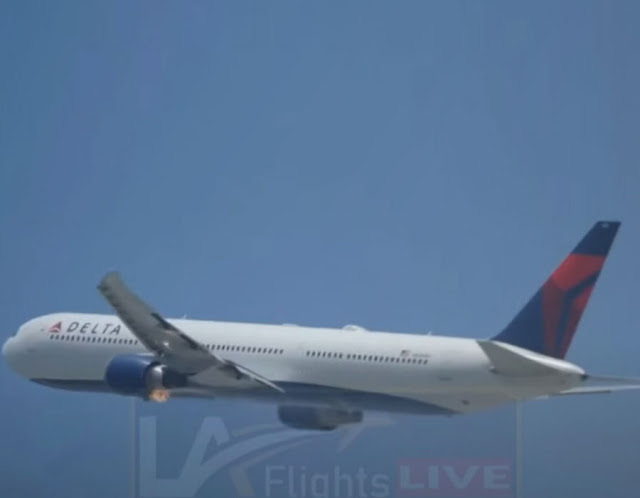Delta flight DL446 made a dramatic emergency landing in LA after an engine fire mid-air. No injuries were reported, but concerns over aviation safety rise.
LOS ANGELES, USA, July 20, 2025:
The recent emergency landing of Delta Air Lines Flight DL446 in Los Angeles on July 18, 2025, following an engine fire shortly after takeoff, has raised significant concerns about aviation safety. Although no injuries were reported among the 200 passengers and crew on board, the dramatic incident has prompted serious questions about aircraft maintenance and the readiness of safety protocols when things go wrong in mid-air.
The Boeing 767-400, en route from Los Angeles to Atlanta, was forced to return to LAX after flames were seen coming from the aircraft's left engine. Video footage captured by passengers aboard the flight quickly went viral on social media, showing flames visibly spewing from the engine while the plane was still climbing into the sky. The quick thinking of the flight crew, who declared an emergency and coordinated closely with Air Traffic Control (ATC), played a pivotal role in ensuring the safe return of the aircraft.
Once airborne, the aircraft climbed over the Pacific Ocean before turning back towards Los Angeles, circling over areas like Downey and Paramount as it conducted safety checks. The plane maintained a steady altitude throughout the procedure, allowing for a controlled descent and a safe emergency landing back at LAX. Emergency response teams were on standby, and thankfully, the fire was extinguished without incident.
While Delta Air Lines has been praised for its swift action during the crisis, this incident is not an isolated one. In January 2025, a similar issue occurred when Delta Flight DL105, an Airbus A330neo, was forced to return to Atlanta after its left engine caught fire shortly after takeoff. The recurrence of engine fire incidents involving Delta raises broader concerns about the airline’s aircraft safety and maintenance procedures.
This second engine fire in less than six months has led many to question whether there are systemic issues within Delta’s fleet, particularly with older aircraft models. The Boeing 767-400, which is over 20 years old, is powered by General Electric CF6 engines, which have been reliable for many years, but the recurrence of such issues begs for closer scrutiny.
The Federal Aviation Administration (FAA) has initiated an investigation into the cause of the engine fire. Investigators will likely focus on a range of factors, including possible mechanical faults, the maintenance history of the engine, and whether the incident could have been prevented by more rigorous inspections or safety measures. It will be crucial for both Delta and the FAA to ensure transparency as the investigation unfolds, especially as the aircraft involved was relatively old.
The issue of aging fleets is a growing concern in the aviation industry, with some experts urging airlines to retire or upgrade older aircraft models to reduce the likelihood of similar incidents. Given that both of Delta’s engine fire cases in 2025 involved older aircraft, this may serve as a catalyst for broader industry-wide discussions about the safety of aging fleets.
One of the critical aspects of this incident was the flight crew’s ability to handle the emergency with professionalism and precision. Passengers reported that the captain was transparent throughout the ordeal, keeping them informed about the situation and reassuring them that emergency crews were actively working to extinguish the fire. This level of communication helped ease passengers’ concerns and ensured that the situation did not escalate into a full-blown crisis.
However, this highlights a critical aspect of aviation safety: while the pilots did an exemplary job, the overall safety of a flight should not solely rely on the crew’s ability to respond to in-flight emergencies. It’s essential for airlines and regulatory bodies to ensure that aircraft systems, maintenance procedures, and safety checks are robust enough to prevent such situations from occurring in the first place.
The recurrence of engine fires on Delta Air Lines this year serves as a stark reminder that no level of training or quick thinking can fully mitigate the risks of in-flight mechanical failures. It raises larger questions about the adequacy of current industry practices surrounding the maintenance of older aircraft, especially when such failures pose a risk to passenger safety.
It is possible that the FAA’s investigation will shed light on any mechanical failures, and if they are found to be systemic, we can expect the aviation industry to implement stricter regulations for the maintenance and retirement of aging fleets. Meanwhile, airlines may need to reassess how they maintain older models and whether additional measures—such as more frequent engine inspections or retrofitting older models—are necessary to ensure passenger safety.
The FAA’s investigation into the cause of this incident will provide crucial insights that may shape the future of aviation safety standards. Whether this incident is an isolated case or indicative of a larger issue remains to be seen, but it will undoubtedly prompt a renewed focus on aircraft maintenance protocols, safety measures for older planes, and pilot training for emergency situations.
As experts continue to analyze the cause of the fire and how the aircraft systems responded during the emergency, passengers, regulators, and airlines alike will be closely watching the findings. Regardless of the outcome, it’s clear that the aviation industry will need to continue evolving to ensure that incidents like this are prevented in the future.
